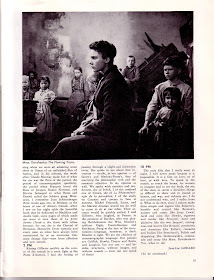quinta-feira, 22 de julho de 2010
segunda-feira, 12 de julho de 2010
quinta-feira, 8 de julho de 2010
« No começo, pensei que era possível a um diretor, imbuído de uma sinceridade juvenil, transmitir isso diretamente. Minhas buscas eram antes de tudo de ordem plástica. O cenário, as oposições dos valores, a harmonia dos movimentos dos atores, achava que isso permitiria a criação de um pequeno universo suficientemente interessante. Logo percebi que dessa maneira só poderia produzir obras bastante frias. As grandes artes, como a filosofia, pintura, música, arquitetura ou poesia, permitem ao autor uma comunicação direta com o público. O autor de filmes dramáticos, como o romancista, deve utilizar a intermediação dos personagens. Só se concedendo a esses personagens uma personalidade autêntica é que se pode fazer com que esses filmes se tornem uma forma de expressão de nossa pobre humanidade; só assim o autor pode tentar, através da descrição sincera dessas almas, deixar transparecer um pouco de seu próprio sentimento. »
Jean Renoir, Como Animo Meus Personagens, Pour Vous, n° 242, 6.7.1933. Republicado em Escritos Sobre Cinema, Pierre Belfond, 1974
terça-feira, 6 de julho de 2010
sábado, 3 de julho de 2010
The complexity and ambiguity of narrative and psychology alike in Rohmer’s work embodies, last of all, a sort of ideal classicism, the most capable of depicting the modern world. Critics, moreover, have always got a little lost here. Is Rohmer classical or modern? Serge Daney, who was far from being the most incompetent of his commentators, wrote in 1982, when A Good Marriage was released: “As a classical filmmaker, Rohmer comes up against the major problem of classicism: he goes faster and faster [. . . ] but the faster he goes, the less he goes anywhere.” And two years later he wrote about Full Moon in Paris that Rohmer “practices a sort of perverse Brechtism,” and that “the modern auteur is jealous of his spectator. His art, in the final analysis, consists in taking us back to the bedroom door. This may be called ‘alienation.’” In reality, Rohmer was probably the only classical French filmmaker to film modernity so accurately and so fully. As a good classical artist, Rohmer thought that life is difficult but simple, and he systematically filmed modern characters who think that life is easy but complicated. So it was in a perverse way that Rohmer would spend the 1980s depicting, in his “Comedies and Proverbs,” young people going astray in phoney problems, and lying to themselves, when their quests are usually objectless and lost from the outset. Where Rohmer is not just a classical artist resides in the fact that, by being the only artist to film the modern world from such a lofty angle, he literally invents, live, characters, gestures, décors, and novel situations which are, by definition, modern. Rohmer’s enemy is not, as people have here and there claimed, modernity, but imprecision. He is a bit like Hawks, his favorite filmmaker, who, at the end of one of the most classic Hollywood films there is, announced in Man’s Favorite Sport? Godard’s abstract ballets of the 1980s, and the soap opera in Red Line 7000, simply filming an irrevocably altered world with his own means. Julien Mahon, Lessons from Éric Rohmer, MAY, Quarterly Journal, n°3 (03 / 2010)


























